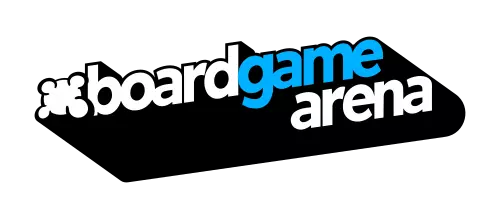Core Concepts:
You have four workers - three of your color, associated with a die, and one neutral worker of value zero. Three shared dice are rolled at the beginning of each round, which will establish the value of everyone's colored workers. For example, if the black die shows a 4, every player's worker with the black die sticker on it is of value 4 for the round.
Each turn you will put one worker on the board, and the worker must meet or exceed the die value on the worker space. All spaces are exclusive (hold only one worker) except for the Palace (top right of main board) and, in 3 or 4 player games, the Harvest and Produce actions.
Each worker space displays a die requirement which your worker must meet by equaling or exceeding the printed die value. The strength of your worker will be the die value of it's assigned die (or zero for your neutral worker), plus any servants (purple figures) you spend, plus any passive bonuses you've earned.
Actions:
Take a card
Much of the board, and of the game, revolves around buying cards. There are four colored towers which comprise the card market each round. To purchase a card:
- Place a worker with sufficient strength onto the worker space adjacent to the card
- If you are the first worker in the tower, this is free. Any subsequent workers must pay 3 coins to enter the tower (always 3, it does not increase with each worker).
- Note: You can only have one of your colored workers in each tower. If you want to visit the same tower twice in a round, one of those workers will have to be your neutral, value 0 worker, inflated by bonuses or servants to meet the die requirement.
- Then take the benefit printed on the action space, if utilizing one of the upper spaces on the board.
Then, pay the cost of the card you are acquiring.
- Green cards have a military requirement (not cost) printed on your personal board. Green cards are placed left to right on the row of trees on your player board, and you must meet the printed requirement on the space the card will occupy.
- All other cards have a printed cost in the upper left.
- Note that purple cards sometimes have military costs - these will have a requirement (black), and your military must be at least this high, and a cost (red), which will be deducted from your military after purchase.
Then you take the card.
- Yellow cards go in the top row of your player board (walls and doors), left to right
- Green cards go in the bottom row of your player board (trees), left to right
- Blue and purple cards go to the right of your player board
Take the immediate benefit:
- Many cards have an immediate benefit in the center of the card, next to a lightning symbol. This happens immediately and once only on purchase.
The bottom of each card will generally have an ongoing benefit as well
- Yellow and Green cards will activate their ongoing benefits with the Produce or Harvest actions, respectively, described below.
- Blue cards have a passive bonus which applies to the rest of the game, usually whenever a given trigger is satisfied (e.g., buying a green card).
- Purple cards have end-of-game point values.
Produce (gear) and Harvest (hatchet)
These are the next most important actions. On the right main board there are two action spaces with a requirement of 1, one with a gear and one with a hatchet. Placing a worker on the gear space will activate all your yellow cards, while placing a worker on the hatchet will activate all your green cards.
Note that the space has a requirement of 1, so any worker (or neutral + servant) can be placed here. However, each green or yellow card will have an individual requirement (bottom left) as well, and individual cards will only trigger if the worker placed meets the strength requirement for that specific card.
Which is to say, you can take these actions with a strength 2 worker, but most of your cards will not fire. If you place a worker of strength 6, you are guaranteed to activate all your cards.
Important note: All cards are considered to activate simultaneously. This is critical for yellow cards which generally have a "pay cost" > "receive benefit" format. All costs must be paid with resources you own prior to taking the action. Which is to say, you cannot take the benefit received from one card and use it to pay the cost of the other. All costs for all cards must be paid (as able or as you choose), and only then will any resources be received.
Market
The market spaces are bottom right corner of the main board. These are self explanatory - place a worker, take the resources.
Palace
The top right has a large box that can hold any number of workers. Place a worker, take 1 coin, and then take any one benefit printed on the scroll below the space.
This box also determines play order for the next round. The first player to use the Palace will go first in the next round, the second will go second, and so forth.
If multiple players do not use the Palace, they will follow the players who used the Palace in the next round. They remain in the same order as they were in the current round.
Notes on the Military Track
The military track serves a few purposes.
- Higher military allows you to take more and more green cards to strengthen your Harvest action.
- Higher military allows you to take, and pay for, better purple cards.
- At end of game, whoever has the most military scores 5 points. Second place scores 2 points.
Notes on the Faith Track
There are 6 rounds in the game. At the end of rounds 2, 4, and 6, the Pope swings through town and sees if you're all good with the Church. You need 3/4/5 faith points to pass muster in the 2nd / 4th / 6th rounds, respectively. There are two outcomes:
- If you can't, or choose not to, pay the round's cost in faith points, you will suffer excommunication. Keep your faith marker where it is, but put a marker on the appropriate excommunication tile. You will suffer this passive penalty for the rest of the game.
- If you have sufficient faith and so choose, score points according to your place on the Piety track, and then pay ALL your faith (reset to zero). You do not get excommunicated.
At the end of the game (round 6), ALL players will score points based on their location on the piety track, even if less than 5. Then those who were below 5 suffer the penalty.
Quick strategy note - unlike Grand Austria Hotel, the cost of keeping the Pope happy is quite high and the penalties are generally manageable. As a new player, you should plan to accept excommunication and it's penalty at least once during the game, if not more. Don't go all in on all three Vatican checkups unless your tableau specifically steers you that way.
End Game
You will score points. This section just a draft.
- Points earned during game (purchasing cards, produce/harvest bonuses, earned from piety track)
- Points based on farthest right green card on your board
- Points from all purple cards
- Points for having the most / second most military
- Anything else?
Points from bottom of your personal board: blue cards and add all remaining resources, gain 1 VP for every 5 resources.

